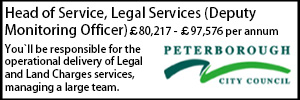Blowing in the wind
 Michael Fahy looks at some of the more contentious property aspects surrounding wind farms.
Michael Fahy looks at some of the more contentious property aspects surrounding wind farms.
- Details
This article is complementary to the recent article from my colleague, David Merson, where David considered the planning aspects of wind farms and stole all the best quotes from Don Quixote.
As highlighted in that article, this interesting area is subject to immense political pressures with both local and European dimensions to satisfy. Europe has set itself a target share of energy usage from renewable sources of 20% by 2020 and the UK has agreed a target of 15% by 2020.
Onshore wind farms continue to play an important role in our efforts to generate ‘green’ energy and achieve these targets. This has been reiterated in the recent National Policy Statement for Renewable Energy Infrastructure, with that Policy stating that, “onshore wind farms are the most established large-scale source of renewable energy in the UK”.
Although seen as crucial to our efforts, wind farms are not without controversy, and as such, there are many related property considerations in the development and operation of these turbines. This article deals with a select number of perhaps the more contentious property aspects involved.
Noise
Without question, the noise generated by wind farms is of significant concern to many and has been the main ground for opposing wind farms, with many claims being issued for nuisance and health related complaints by those living within the vicinity of the turbines.
Wind turbines produce two main types of noise – mechanical noise from the gearbox and the generator, and aerodynamic noise caused by the passage of air over the turbine blades. The aerodynamic noise is amplitude modulated; i.e. its volume rises and falls as the turbine blades rotate.
In 1996, a working group was set up by the DTI to examine the noise levels from turbines. The concluding report, referred to as ETSU-R-97, permits noise from turbines up to 5dB above background noise or 35 – 45 dB during the day and 43dB during the night, whichever is greater. It was suggested that at these levels the noise generated by wind turbines would not disturb local residents.
ETSU-R-97 advises that the noise levels recommended in its report take into account ‘blade swish’ (i.e. aerodynamic modulation); however, critics argue that the loud thumping noises, audible even at great distances, generated by aerodynamic modulation are yet to be properly considered.
Critics have also asserted that wind turbines give off infrasound waves (low frequency noise) which can cause distress, nausea, headaches and anxiety. However, studies have concluded that any infrasound produced is not of a consequential level and therefore not harmful. Interestingly, the Claimants in the recent High Court case of Deeping St Nicholas argued that they had been driven from their home after eight wind turbines began operating nearby and caused them to feel nauseous. As you might imagine, the case attracted a great deal of public attention, however, was mysteriously settled in November 2011 on terms that were confidential.
Opponents to wind farms may find comfort in the new Wind Turbine Minimum Distance Bill – recently revived by Parliament as a Private Peers Bill. The Bill provides for minimum separation distances between wind turbines and neighbouring land owners of between 1000 and 3000 metres. If implemented, this would greatly reduce the number of potential sites available for future wind farm development. No date has yet been set for its second reading and its success is likely to require Government support.
Mineral rights
It is often difficult to tell if mineral rights exist and they may not be registered with the land registry. Even if there are known mineral rights, it is hard to know whether the digging of foundations for a wind turbine amounts to an interference with those rights.
If mineral rights exist in land that has a wind farm development on it, then the developer runs the risk that the owner of the mineral rights may try and dig up the land and excavate the minerals. Furthermore, because the installation of wind turbines requires fairly deep excavation, the installation may interfere with the ownership of the mines and minerals under the surface. In theory, this could give rise to the owner of those minerals issuing legal proceedings against the developer for trespass.
For this reason, a developer should carry out all available checks to identify any minerals, such as soil surveys, and consider whether the minerals will be affected and, if so, the value of any potential claim. Permission should always be sought from the owner of the mineral rights (where possible) if you are considering carrying out any work that might affect them. If the owner is unidentifiable, developers should consider taking out indemnity insurance.
Easements
It is not possible to acquire a right to an uninterrupted passage of air (save in relation to a defined aperture, which is not a relevant exception in this instance).
The leading case on this area is that of Webb v Bird (1863) 13 CB 841. The claimant in that case was the owner of a windmill built in 1829. In 1860, the defendant erected a school some 25 yards away from the windmill. The claimant argued that he had a right to a flow of air as a prescriptive easement as his land had enjoyed the free flow of air for over 20 years.
It was held that the right to the passage of air is not a right to an easement within the Prescription Act 1832. The presumption of a grant from long continued enjoyment only arises where the person against whom the right is claimed might have interrupted or prevented the exercise of the subject of the supposed grant. Given the changing wind directions this would only have been possible if the defendant had built a wall all the way around the windmill. Consequently, the owner of the windmill had no remedy.
This is an interesting area of law and an issue that could foreseeably arise in practice. For example, a neighbouring landowner could try to frustrate plans for a wind turbine by obtaining planning permission to build a structure sufficiently close enough to the turbine to impede its effectiveness.
In addition to the above, easements will be required for the installation and maintenance of access tracks and electrical cabling.
Conclusion
The energy department has recently unveiled its plans to cut the subsidies received in respect of onshore wind by 10%. In fact, the chancellor, under ever-mounting pressure to scrap subsidies altogether, is said to favour a 25% cut. Renewable UK have responded with comments that a cut of over 10% could be a cause for judicial review, given that any such cut would be contrary to specific guidance previously provided to the Government.
The Government seems to be at cross-purposes when it comes to deciding wind farm policy. On the one hand, wind farms are relied upon as the major source for renewable energy and therefore play an essential role in meeting our various targets; on the other hand, query how this is possible in the face of legislative restrictions such as the Turbine Minimum Distance Bill and plans to cut subsidies.
In light of growing public dissent and what appears to be a change of direction in terms of policy, it is vital that developers consider the full property implications of their development.
Michael Fahy is the Head of the Property Department at Steeles Law. He can be contacted on 020 7421 1720 or by
Senior Lawyer - Contracts & Commercial
Trust Solicitor (Employment & Contract Law)
Lawyer - Property
Contracts & Procurement Lawyer
Locums
Poll










































